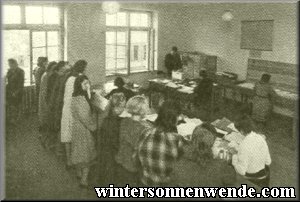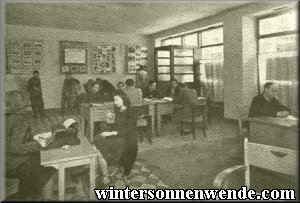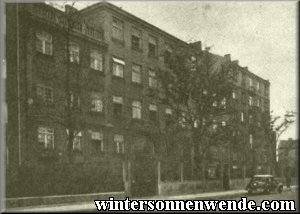  |
The Labor Force
When the National Socialist Party came to power in 1933, more than 7 million people in the Reich were out of work. Some of them had endured the bitter lot of unemployment for years. National Socialism has eliminated this deplorable state of affairs completely, and this must ever be considered one of its greatest achievements.
The great number and scope of the tasks which have been tackled under National Socialism have led to a reversal of the situation; the Reich is now no longer a nation of unemployment but rather one of labor shortage. This shortage has grown in severity as the present war escalated more and more into a second world war in the course of the past several years.
Never before in history has any war shifted and resettled so many people of all European nations as the present war. Workers from more than 20 European nations have come to the Reich to fill the vacancies. The registration, relocation and judicious placement of these workers has become more and more a political responsibility and
war-economical necessity.

Placement Center of the Warsaw Labor Office.
|
Immediately upon conclusion of the Polish Campaign it was the responsibility of the General Government to integrate the former Polish region and the Polish people into the war economy of the Reich. For Warsaw in particular, being the seat of the former Polish war industry, this posed a twofold task.
For one, it was necessary to co-ordinate the labor resources of Warsaw with the jobs in the Reich. This required the registration, classification and assessment of the people according

Center for the recruitment of skilled workers.
|
to their knowledge and skills; it was necessary not only to fill the great gaps in the German agricultural system but also to satisfy the severe shortages of labor in the commercial and industrial sectors which had resulted from war programs, increased output in all sectors, conscription by the Wehrmacht, and the war itself.
The other task was to fill the many production orders placed by the Reich and now transferred to the General Government.
It is difficult enough to carry out such measures in a nation of
well-disciplined people. It is all the more difficult with a populace that has grown up in a completely different
mind-set and which, moreover, is under the sway of political incitement which makes any sort of "recruitment" campaign extraordinarily difficult.

Invitation to industrial emigrant workers:
"Come to Germany!!"
|
In past years, tens of thousands of seasonal workers, particularly from Poland, had gone to the Reich to find employment as farmworkers. Even though these workers had experienced far better conditions there than they had ever encountered in Poland, it was at first difficult to recruit agricultural workers back to the Reich. But this changed when letters and accounts from Polish farmhands in the Reich reached their families. Many a Pole had never before slept in a bed as clean as the one he or she had in the Reich. Time and again, the letters of these Polish farmhands told with amazement of, for example, the electrical lighting in the cattle barns, whereas entire villages in Poland might be without electrical light. Letters also spoke appreciatively of the fact that the German farmers were by no means stingy in their reward for a good day's work, and that workers were also frequently given gifts of clothing. All these reports were such a complete contradiction of the propaganda which the Poles had been exposed to before that the aversion to resettlement into the Reich gradually diminished.
And so the recruitment officers who had been sent by the German authorities and who often visited even the most remote villages despite adverse conditions such as blizzards or driving rain, had gratifying successes to show for their efforts: no fewer than 64,000 Polish farm workers were resettled between the end of 1939 and May 1942. This is an impressive contribution by the District of Warsaw to the labor force.
Parallel to this continual recruitment of agricultural workers there was also a growing need to provide skilled labor to meet the extensive requirements of the Reich's war economy.

Transit camp in Warsaw.
|
The city zone of Warsaw was almost the only reserve of such skilled labor. It was often very difficult to determine all the unused potential, to effect the rationalization of businesses, and to take inadequately placed workers out of expendable production streams.
By the end of May 1942, however, these measures had enabled the resettlement of 30,700 skilled workers and assistants into the Reich without harming the economy of the District itself. Including the agricultural laborers, therefore,
94 700 workers
have been transferred from the District of Warsaw to the Reich.
In the course of these labor measures almost 100,000 people passed through the Warsaw reception camp to be deloused. More than 600 transports were required; huge quantities of food were consumed in the camp and during the transports. But all the effort and trouble has already paid off.
   Warsaw Under German Rule
Warsaw Under German Rule
German Reconstruction and Development in the District of Warsaw
|
|